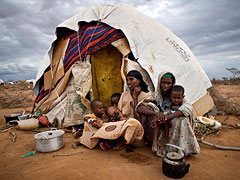
In lowland areas of the Horn of Africa, droughts and floods are frequent events, but the scale of the 2011 food emergency was somewhat unusual. Why is the region seemingly more vulnerable now than it has been in the past? How can development efforts be improved to render the people who live and work in the Horn more resilient to the next emergency? The answers to these questions are complex.
While drought obviously greatly contributed to the 2011 crisis, the role that the conflict in Somalia played cannot be ignored. In addition, even slower-moving stresses have long undermined the progress of communities in the region, including, for example, the reduction of herd sizes and the loss of herd mobility. Identifying the root causes of these stresses is far from easy, but those who have researched the topic can agree that a vicious cycle involving population growth, local conflicts, land fragmentation, and reduced mobility is at fault.
Enhancing resilience in the Horn of Africa requires striking a balance between strengthening pastoralism—the region’s primary economic activity—and promoting meaningful economic diversification. Currently, the most common secondary occupation is to collect and sell natural products like firewood and charcoal. This livelihood not only has incredibly low returns but also causes long-term damage to an already fragile environment.
Migration and urbanization may seem more promising options to people living in the Horn of Africa, but the main prerequisite for successful migration and urbanization is greater investment in education, which, if undertaken successfully, could have major impacts over the next 10 years. Health and nutrition interventions are also a top priority for pastoralists.
Other pro-poor improvements to the livestock sector that could prevent future famine or other types of crises include strengthening market competition, access, and efficiency to enable pastoralists to buy and sell livestock before a drought for higher prices, rather than losing their herds to drought-induced mortality. Better management and regulation of land and water resources will also be critical to avoid the negative impacts herders often face, including the fallout of poorly implemented and designed irrigation schemes, “land grabs,” and the generally weak protection of community property rights. These land policies are not only unjust, but also inefficient because they inhibit the performance of the livestock sector and interfere with the principal mechanism pastoralists use to cope with drought: mobility.
New technologies and institutional innovations could also help mitigate the disadvantages of distance and the vagaries of the climate in the Horn. Mobile phones are likely to be particularly critical for reducing economic distance, and innovations like weather insurance, microfinance, and education also hold promise. Ultimately, though, figuring out what works and what does not will require greater investment, systematic experimentation, and more rigorous scientific evaluation.
IFPRI’s 2011 Global Food Policy Report—the first in a new annual series—reflects on the challenges and developments of 2011 and provides an outlook for 2012.
- Launch Seminar: April 23
- Full Report
- Preview booklet: English | Français
- Media materials
- All related video
Download in PDF